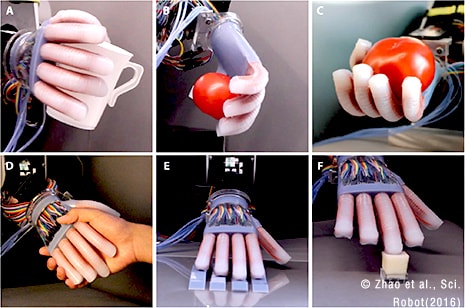Engineers use fluidically powered soft actuator to power artificial limb
Orange County, CA - January 9th 2017 - Nearly 2 million people in the United States live with the loss of a limb and the number is expected to more than double by 2050, rising to 3.6 million people. Every day more than 500 people lose a limb, this has a wide range of both physical and psychological effects on a person. Losing more than just mobility, touch is a powerful sense that allows us to explore the world. To increase the quality of life for those living with the loss of a limb, engineers from Cornell University have created a soft robotic hand prosthetic sensitive enough to feel both shape and texture.
The device is able to sense touch by using optical waveguides integrated into a soft, stretchable prosthetic. Previous soft robotics were incapable of integrating sensitivity sensors to the pliable material, making them unable to communicate tactile information through the prosthetic's material. Scientists have found a way to change that.
Optical waveguides, like fiber optic cables, are capable of transmitting light internally between points. As the light passes through the waveguide material, being malleable, the light can potentially manipulate its previous parameters. The prosthetic is then able to measure those parameters and determine the shape of the material it’s moving, the outcome being in a sensitive flexibility sensor.

The researchers tested their prosthetic hand by having it grab multiple objects searching for distinct details of shape and texture. Most notable of the tests was the prosthetic’s ability to discern which of three tomatoes was the ripest. Testing for touch and feel mimics the real-life ability and skill a hand possesses, proving its capability without added motors or a stiff façade.
“Most robots today have sensors on the outside of the body that detects things from the surface,” said Huichan Zhao, doctoral student and lead author of the published research. “Our sensors are integrated within the body, so they can actually detect forces being transmitted through the thickness of the robot, a lot like we and all organisms do when we feel pain, for example.”
There’s a lot of work to be done before reaching the team’s ultimate goal of fluidically powered soft actuators, but they’re confident in their research. The current prototype of the prosthetic is being improved with engineers working to implement increased sensory density. Through the use of a 3D printer, more possibilities exist than ever at a relatively low cost of production. Zhao and his team are hopeful in the proceedings of their research.
Contact Ampronix:

Email: info@ampronix.com
International Sales: +1 949-273-8000
Domestic Sales: 1800-400-7972 for US and Canada
Follow Us:
Share This Article:
View our Product Catalog Online Here
About Ampronix
Ampronix is a renowned authorized master distributor of the medical industry's top brands as well as a world-class manufacturer of innovative technology. Since 1982, Ampronix has been dedicated to meeting the growing needs of the medical community with its extensive product knowledge, outstanding service, and state-of-the-art repair facility. Ampronix prides itself on its ability to offer tailored, one-stop solutions at a faster and more cost-effective rate than other manufacturers. Ampronix is an ISO & ANSI/ESD certified facility. To learn more go here.
Engineers use fluidically powered soft actuator to power artificial limb Orange County, CA – January 9th 2017 – Nearly 2 million people in the United States live with the loss of a limb and the number is expected to more than double by 2050, rising to 3.6 million people. Every day more than 500 people […]



